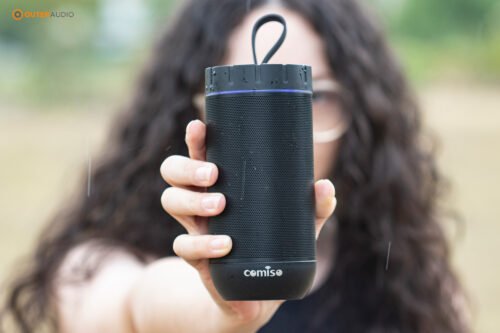Classical music is a whole different beast. It’s not about bass drops, crunchy riffs, or vocal hooks—it’s about detail, dynamics, and space. From the delicate flutter of a violin to the thunder of a full orchestra, classical music demands clarity and balance. If your Bluetooth speaker is smearing the strings or turning a piano concerto into background mush, don’t blame the music. With the right EQ tweaks, even a modest speaker can bring out the richness and nuance classical music deserves. Here’s how to get there.
My Recommended EQ Settings for Classical Music
- Bass (Low Frequencies: 20–250 Hz)
- Set: Slight boost or flat, around +1 to +2 dB
- Why: You want warmth and fullness for cellos, double bass, and timpani—but too much bass and you’ll muddy up the rest of the orchestra. Keep it tasteful.
- Midrange (250 Hz–4 kHz)
- Set: Neutral to slight boost, around +1 to +3 dB
- Why: This is the heart of classical music—violins, piano, horns, and most of the orchestra sit right here. If you want real presence and realism, don’t mess this up.
- Treble (High Frequencies: 4–20 kHz)
- Set: Moderate boost, around +3 dB
- Why: A touch of brightness adds air and detail to strings, flutes, and room ambience. It helps bring the concert hall to your living room, without the pricey tickets.
- Presence Range (1–4 kHz)
- Set: Slight boost, around +2 dB
- Why: If you want clarity in solo instruments or orchestral detail, this is the zone to nudge. It sharpens things up, but go easy or it’ll get harsh.
- High Treble (10–20 kHz)
- Set: Slight boost, around +2 dB
- Why: This adds sparkle and lets high-end instruments breathe. Great for harps, triangles, and the natural reverb of the recording space.
- Sub-Bass (<50 Hz)
- Set: Flat or minimal boost
- Why: Classical music doesn’t spend much time down here. Maybe a subtle bump for orchestral percussion, but too much and you’ll just create unnecessary rumble.
Why These Settings Work for Classical
- Detail Over Impact: Unlike bass-driven genres, classical thrives on precision. You’re not looking for thump—you’re looking for texture.
- Full Dynamic Range: Classical pieces can go from whisper-quiet to full-blown thunder in seconds. These settings help preserve that dynamic range instead of flattening it out.
- Natural Soundstage: Classical is meant to sound like it’s happening in a room—not a box. A balanced EQ keeps things spacious and organic, not squished and artificial.
- Instrument Clarity: With a hundred instruments potentially playing at once, every bit of definition helps. Boosting mids and treble (carefully) helps the complex mix breathe.
Additional Tips
- Let It Breathe: Classical needs space. Don’t tuck your speaker into a corner—place it where it can project evenly. Even better if your speaker does 360° sound.
- Genre-Specific Adjustments: Solo piano? Maybe roll off the bass slightly. Full orchestra? Bring in a little more low-end and upper treble to give it depth and scale.
- Use Good Recordings: No EQ trickery can save a flat or overly compressed recording. Classical music needs good mastering to shine, so choose your sources wisely.
- App Presets: If your speaker app has an “Acoustic” or “Classical” preset, try it—but be ready to tweak. Most are too flat or overly bright for real classical listening.
Best Bluetooth Speakers for Classical Music
Not every speaker is cut out for classical. You need something that can handle delicate detail, wide dynamics, and a natural soundstage. These five portable Bluetooth speakers stand out for their ability to bring classical recordings to life, whether you’re listening to a solo violin or a full symphony.
Great Classical Tracks to Test Your EQ Settings
Before you settle on your EQ adjustments, it’s worth running a few test tracks to see how your speaker handles different dynamics, textures, and tonal ranges. Classical music is full of subtlety and wide frequency swings, so choosing the right pieces can help you fine-tune your sound with confidence. Here are four excellent choices to help you dial things in:
- Beethoven – Symphony No. 5 in C minor, Op. 67
The iconic opening movement is perfect for testing dynamic range and bass control. Listen for the punch of the lower strings and timpani—your EQ should let them hit hard without overwhelming the rest of the orchestra. - Debussy – Clair de Lune
This delicate piano piece is ideal for checking midrange warmth and clarity. You’ll want to hear every nuance in the keystrokes without any harshness or artificial brightness in the higher registers. - Mozart – Clarinet Concerto in A Major, K. 622
This piece is great for assessing the balance between solo instrument and orchestra, especially in the second movement. Pay attention to the smoothness of the clarinet and how well it sits against the lighter strings and woodwinds. - Mahler – Symphony No. 2 “Resurrection” (Finale)
A full orchestral workout with massive swells and choral climaxes. Use this to test your speaker’s ability to handle scale—if your EQ is dialed in, nothing should distort or get lost, even when the piece gets epic.
Let the Music Breathe
Classical music isn’t background noise—it’s a full-on experience. With the right EQ settings, you’ll catch every nuance, every subtle harmony, every room echo you didn’t even know was in the recording. This is the kind of music that rewards close listening, and your Bluetooth speaker—yes, even that little portable one—can absolutely rise to the occasion. Just give it a fighting chance. Adjust those settings, press play on something lush, and let the music do the rest.











